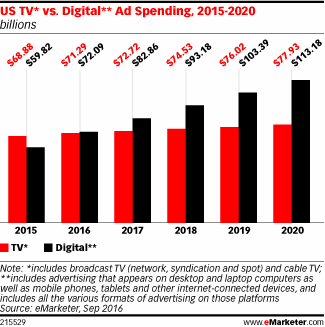
At one point in our lives, perhaps after a long day at work, we’ve all looked forward to going straight home and heading to this big screen called the “television”. The television allows us to escape from the real world while living in a fantasy sphere. The television, in its traditional format, also delivers 30-second advertisements designed to keep of informed of the trends and products in which we should invest. Yet, over time, as technology becomes increasingly ubiquitous, our focus has slowly begun to be centered towards gadgets and alternative forms of video entertainment.
As our attention becomes diverted from the big screen to the small screen via more convenient hand held devices, the advertising industry is quickly making a shift towards different outlets to connect with their target audiences. Most everyone now owns a smartphone, tablet or laptop. Let’s admit it, who doesn’t have one?
With this, according to the Magna Global, “Digital advertising will surpass television advertising by $66B in revenue in the U.S by the end of 2016.”

While the rise of digital advertising is clearly outpacing television advertising, a stream of headlines are put in to play:
- Mobile is Key
Our attention to a mobile device is rising faster than ever. TV shows and general news were the main contributors television reliance. According to PewResearch, there are about “4 in 10 Americans, 72% of adults that now received news online.” While most of the audience are millennials, news outlets like Wall Street Journal and Forbes are offering subscriptions online. Online news has become prominent due to traveling time to work. Additionally, on-demand subscription services, like Hulu and Netflix, offer easy access sites that allows users to watch TV shows on one app with the option to opt out of commercials for an additional small price. With the copious amounts of accessibility that mobile devices offer, people can easily take their news and entertainment on the go.
- Social Media Hits a Powerful Storm
“62% of U.S. Americans receive news on Facebook, and 18% do every so often.” (Pew Research) As more time is spent on social media, advertising is a binding factor glued within posts. Facebook is a perfect example of users that are heavily involved. This is due to the accessibility to reading the news, connecting with friends and family, and exploring a marketplace. All in all, making it a perfect place to hit users with advertisements that pertain to them. The interest and stories social media feeds upon an individual is a contributor to why advertisement banners play a big role. Making it an ideal platform for digital advertising to see everything you would like to see in one space setting.
- $$$ Fewer Dollars = More Opportunity
According to the above graph, E-marketer presents “Advertisers will have spent $72.09 billion on U.S. digital advertising by the end of 2016, while TV spending will account for $71.29 billion. This will give digital a 36.8% share in media ad spending, slightly higher than TV’s 36.4%.” Although television commercials are relatively high in pricing for a 30 second ad, traditional advertising has become overall too expensive. Since inventory on publisher sites are more cost efficient, this in exchange, enhances the opportunity for advertisers to spend more on social and mobile. Not only does this mean extra funds, but heightens the use of video and search.
- The User Is in Control
As advertisers, our predilection for data and studying trends is never ending. We study data on a day-to-day basis to consistently bring in new trends. This still holds true for traditional television advertising, yet the granularity of data in digital allows us to combat the fact that in today’s world the user chooses how to interact with your brand. We are able to track user behavior, browsing history, purchase intent, content consumption, and a massive list of data points, thus feeding into the appropriate ad to showcase to the user. As for the reader, they have a “choice” on what to hear, watch, or read. Whether programmatic, video, native or social, advertisers are able to create an immersive user-experience backed by data. The user is in control, but advertisers are coming armed.
The bottom line is trends are consistently shifting and advertising continues to increase in complexity. Whether targeting uses who are sticking to the norm of watching a show on television or those streaming on demand via mobile phones or both, we must keep moving along with the trend. Digital advertising is booming faster than ever and we must keep up. The train never stops in the media world.
Camille Nepacena
Just Media, Inc.
Sources:
https://www.salesforce.com/blog/2016/02/key-trends-transforming-advertising-2016.html
https://www.emarketer.com/Article/US-Digital-Ad-Spending-Surpass-TV-this-Year/1014469
http://www.forbes.com/sites/brandonkatz/2016/09/14/digital-ad-spending-will-surpass-tv-spending-for-the-first-time-in-u-s-history/#60ef0616959c
http://www.pewresearch.org/fact-tank/2016/09/14/facts-about-the-changing-digital-news-landscape/
http://www.wsj.com/articles/digital-ad-spending-in-u-s-to-surpass-television-spending-in-2016-1444937398
